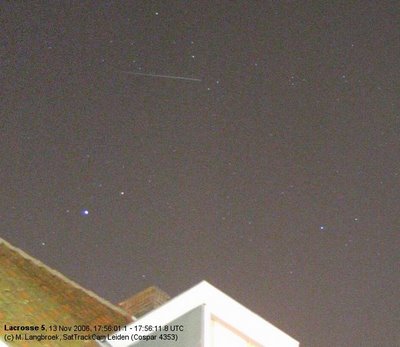(click images to enlarge)


The satellite showed a rather irregular brightness behaviour. While I was setting up my camera it made a short bright flare to mag. 0 low in the west at about 17:53:50 UTC (+/- 10s) lasting only a few seconds. After that it went back to much less brightness (mag +2 to +2.5).
While climbing towards Vulpecula it brightened slowly to mag. +1.5 at 17:55:00 - 17:55:10 UTC. The first of the above pictures captures it during this bright phase.
Next I had to operate the camera, but when looking up at around 17:55:30 it was fainter, about +2.5. Between 17:55:50 and 17:56:10 UTC it brightened again to +1.5 in Vulpecula during a few seconds, then quickly dimmed again and actually went out of visual detection range for me just after 17:56:10 UTC. I captured the peak brightness and fading part on photograph, the rapid fading near the end is apparent in it. See the second picture above (satellite movement is from right to left).
Note that the satellite was nowhere near shadow entry at this moment: in fact, it should have been approaching its maximum brightness at this moment instead of fading.
Update: the endpoint on the second image turns out to be the point where the satellite brightness drops below the imaging sensitivity treshold of the camera, some 1.5 seconds before the end of the exposure: see update post here.
No comments:
Post a Comment